Dynamometric Investigation on Airborne Particulate Matter (PM) from Friction Materials for Automobile: Impact of Abrasive and Lubricant on PM Emission Factor
Abstract
:1. Introduction
2. Materials and Methods
2.1. Brake Dynamometer
2.2. Particulate Matter Measurements
2.3. Materials
2.4. Analysis
3. Results
3.1. Dynamometric Time-Dependent Profile
3.2. Wear Debris Analysis
4. Discussion
4.1. Surface Profile Analysis
4.2. Temperature Effect
5. Conclusions
- As for lubricants, particle number concentration is inversely proportional to the size of graphite. Smaller graphite (10 μm) generates more nano-sized particles than that of larger size (700 μm).
- As hardness of abrasive increases (SiC > Al2O3 > ZrSiO4), higher emission factor was obtained, which suggests that abrasive wear directly contributes to emissions, evidenced by surface topology.
- Temperature-dependent data imply that particle emission for SiC abrasive is initiated at lower disc temperature (Tdisc) of ~100 °C, than that for ZrSiO4 (Tdisc >120 °C).
- According to chemical analysis of wear debris, larger micron-sized particle includes fragmented Fe lumps from disc of grey cast iron, whereas smaller particles with various shapes are formed by oxidation and aggregation of nano-sized particles with or without a core of Fe lump.
Supplementary Materials
Author Contributions
Funding
Institutional Review Board Statement
Informed Consent Statement
Data Availability Statement
Conflicts of Interest
References
- Grigoratos, T.; Martini, G. Brake wear particle emissions: A review. Environ. Sci. Pollut. Res. 2015, 22, 2491–2504. [Google Scholar] [CrossRef] [PubMed] [Green Version]
- Hicks, W.; Beevers, S.; Tremper, A.H.; Stewart, G.; Priestman, M.; Kelly, F.J.; Lanoisellé, M.; Lowry, D.; Green, D.C. Quantification of Non-Exhaust Particulate Matter Traffic Emissions and the Impact of COVID-19 Lockdown at London Marylebone Road. Atmosphere 2021, 12, 190. [Google Scholar] [CrossRef]
- Bukowiecki, N.; Lienemann, P.; Hill, M.; Furger, M.; Richard, A.; Amato, F.; Prévôt, A.S.H.; Baltensperger, U.; Buchmann, B.; Gehrig, R. PM10 emission factors for non-exhaust particles generated by road traffic in an urban street canyon and along a freeway in Switzerland. Atmos. Environ. 2010, 44, 2330–2340. [Google Scholar] [CrossRef]
- Jeong, C.-H.; Traub, A.; Huang, A.; Hilker, N.; Wang, J.M.; Herod, D.; Dabek-Zlotorzynska, E.; Celo, V.; Evans, G.J. Long-term analysis of PM2.5 from 2004 to 2017 in Toronto: Composition, sources, and oxidative potential. Environ. Pollut. 2020, 263, 114652. [Google Scholar] [CrossRef]
- Beddows, D.S.C.; Harrison, R.M. PM10 and PM2.5 emission factors for non-exhaust particles from road vehicles: Dependence upon vehicle mass and implications for battery electric vehicles. Atmos. Environ. 2021, 244, 117886. [Google Scholar] [CrossRef]
- Rexeis, M.; Hausberger, S. Trend of vehicle emission levels until 2020—Prognosis based on current vehicle measurements and future emission legislation. Atmos. Environ. 2009, 43, 4689–4698. [Google Scholar] [CrossRef]
- Harrison, R.M.; Allan, J.; Carruthers, D.; Heal, M.R.; Lewis, A.C.; Marner, B.; Murrells, T.; Williams, A. Non-exhaust vehicle emissions of particulate matter and VOC from road traffic: A review. Atmos. Environ. 2021, 262, 118592. [Google Scholar] [CrossRef]
- Harrison, R.M.; Jones, A.M.; Gietl, J.; Yin, J.; Green, D.C. Estimation of the contributions of brake dust, tire wear, and resuspension to nonexhaust traffic particles derived from atmospheric measurements. Environ. Sci. Technol. 2012, 46, 6523–6529. [Google Scholar] [CrossRef]
- Garg, B.D.; Cadle, S.H.; Mulawa, P.A.; Groblicki, P.J.; Laroo, C.; Parr, G.A. Brake Wear Particulate Matter Emissions. Environ. Sci. Technol. 2000, 34, 4463–4469. [Google Scholar] [CrossRef]
- Sanders, P.G.; Xu, N.; Dalka, T.M.; Maricq, M.M. Airborne Brake Wear Debris: Size Distributions, Composition, and a Comparison of Dynamometer and Vehicle Tests. Environ. Sci. Technol. 2003, 37, 4060–4069. [Google Scholar] [CrossRef] [PubMed]
- Kumar, P.; Pirjola, L.; Ketzel, M.; Harrison, R.M. Nanoparticle emissions from 11 non-vehicle exhaust sources—A review. Atmos. Environ. 2013, 67, 252–277. [Google Scholar] [CrossRef] [Green Version]
- Hagino, H.; Oyama, M.; Sasaki, S. Laboratory testing of airborne brake wear particle emissions using a dynamometer system under urban city driving cycles. Atmos. Environ. 2016, 131, 269–278. [Google Scholar] [CrossRef] [Green Version]
- Brunekreef, B.; Forsberg, B. Epidemiological evidence of effects of coarse airborne particles on health. Eur. Respir. J. 2005, 26, 309–318. [Google Scholar] [CrossRef] [PubMed]
- Oberdörster, G.; Oberdörster, E.; Oberdörster, J. Nanotoxicology: An emerging displine evolving from studies of ultrafine particles. Envron. Health Perspect. 2005, 113, 823–839. [Google Scholar] [CrossRef]
- Iijima, A.; Sato, K.; Yano, K.; Kato, M.; Kozawa, K.; Furuta, N. Emission factor for antimony in brake abrasion dust as one of the major atmospheric antimony sources. Environ. Sci. Technol. 2008, 42, 2937–2942. [Google Scholar] [CrossRef] [PubMed]
- Iijima, A.; Sato, K.; Yano, K.; Kato, M.; Tago, H.; Kato, M.; Kimura, H.; Furuta, N. Particle size and composition distribution analysis of automotive brake abrasion dusts for the evaluation of antimony sources of airborne particulate matter. Atmos. Environ. 2007, 41, 4908–4919. [Google Scholar] [CrossRef]
- Baron, P.A.; Willeke, K.; Kulkarni, P. Aerosol Measurement: Principles, Techniques, and Applications, 3rd ed.; Wiley & Sons: New York, NY, USA, 2011; Chapter 2. [Google Scholar]
- Hagino, H.; Oyama, M.; Sasaki, S. Airborne brake wear particle emission due to braking and accelerating. Wear 2015, 334–335, 44–48. [Google Scholar] [CrossRef]
- zum Hagen, F.H.F.; Mathissen, M.; Grabiec, T.; Hennicke, T.; Rettig, M.; Grochowicz, J.; Vogt, R.; Benter, T. Study of Brake Wear Particle Emissions: Impact of Braking and Cruising Conditions. Environ. Sci. Technol. 2019, 53, 5143–5150. [Google Scholar] [CrossRef]
- PMP-Group Particle Measurement Program (PMP) of the United Nations Working Party on Pollution and Energy (UNECE–GRPE). Available online: https://unece.org/transport/documents/2021/02/standards/un-regulation-no-154-worldwide-harmonized-light-vehicles-test (accessed on 1 December 2021).
- Mathissen, M.; Grochowicz, J.; Schmidt, C.; Vogt, R.; Farwick zum Hagen, F.H.; Grabiec, T.; Steven, H.; Grigoratos, T. A novel real-world braking cycle for studying brake wear particle emissions. Wear 2018, 414–415, 219–226. [Google Scholar] [CrossRef]
- Chan, D.; Stachowiak, G.W. Review of automotive brake friction materials. Proc. Inst. Mech. Eng. D J. Automob. Eng. 2004, 218, 953–966. [Google Scholar] [CrossRef]
- Park, J.; Joo, B.; Seo, H.; Song, W.; Lee, J.J.; Lee, W.K.; Jang, H. Analysis of wear induced particle emissions from brake pads during the worldwide harmonized light vehicles test procedure (WLTP). Wear 2021, 466–467, 203539. [Google Scholar] [CrossRef]
- Kim, S.; Shim, W.; Kwon, S.-U.; Lee, J.-J.; Seo, M.-W.; Kim, J.-K.; Pee, J.-H.; Kim, J.-Y. The impact of composition in non-steel and low-steel type friction materials on airborne brake wear particulate emission. Tribol. Lett. 2020, 68, 118. [Google Scholar] [CrossRef]
- Osterle, W.; Prietzel, C.; Kloß, H.; Dmitriev, A.I. On the role of copper in brake friction materials. Tribol. Int. 2010, 43, 2317–2326. [Google Scholar] [CrossRef]
- Cho, M.H.; Ju, J.; Kim, S.J.; Jang, H. Tribological properties of solid lubricants (Graphite, Sb2S3, MoS2) for automotive brake friction materials. Wear 2006, 260, 855–860. [Google Scholar] [CrossRef]
- Gilardi, R.; Alzati, L.; Thiam, M.; Brunel, J.-F.; Desplanques, Y.; Dufrénoy, P.; Sharma, S.; Bijwe, J. Copper Substitution and Noise Reduction in Brake Pads: Graphite Type Selection. Materials 2012, 5, 2258–2269. [Google Scholar] [CrossRef] [Green Version]
- Kukutschová, J.; Moravec, P.; Tomásek, V.; Matejka, V.; Smolík, J.; Schwarz, J. On airborne nano/micro- microsized wear particles released from low-metallic automotive brakes. Environ. Pollut. 2011, 159, 998–1006. [Google Scholar] [CrossRef] [PubMed]
- Alemani, M.; Wahlström, J.; Olofsson, U. On the influence of car brake system parameters on particulate matter emissions. Wear 2018, 396–397, 67–74. [Google Scholar] [CrossRef]

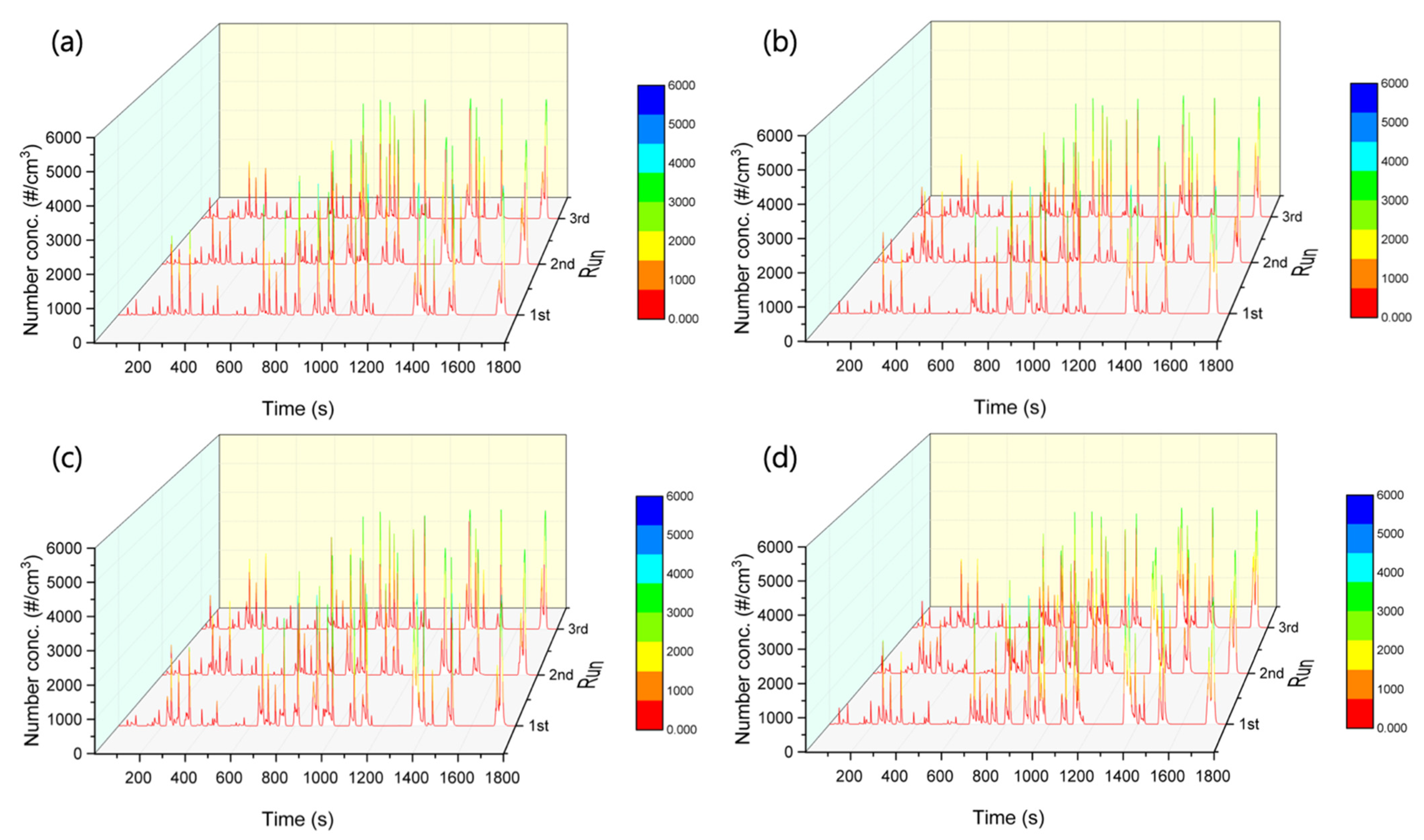
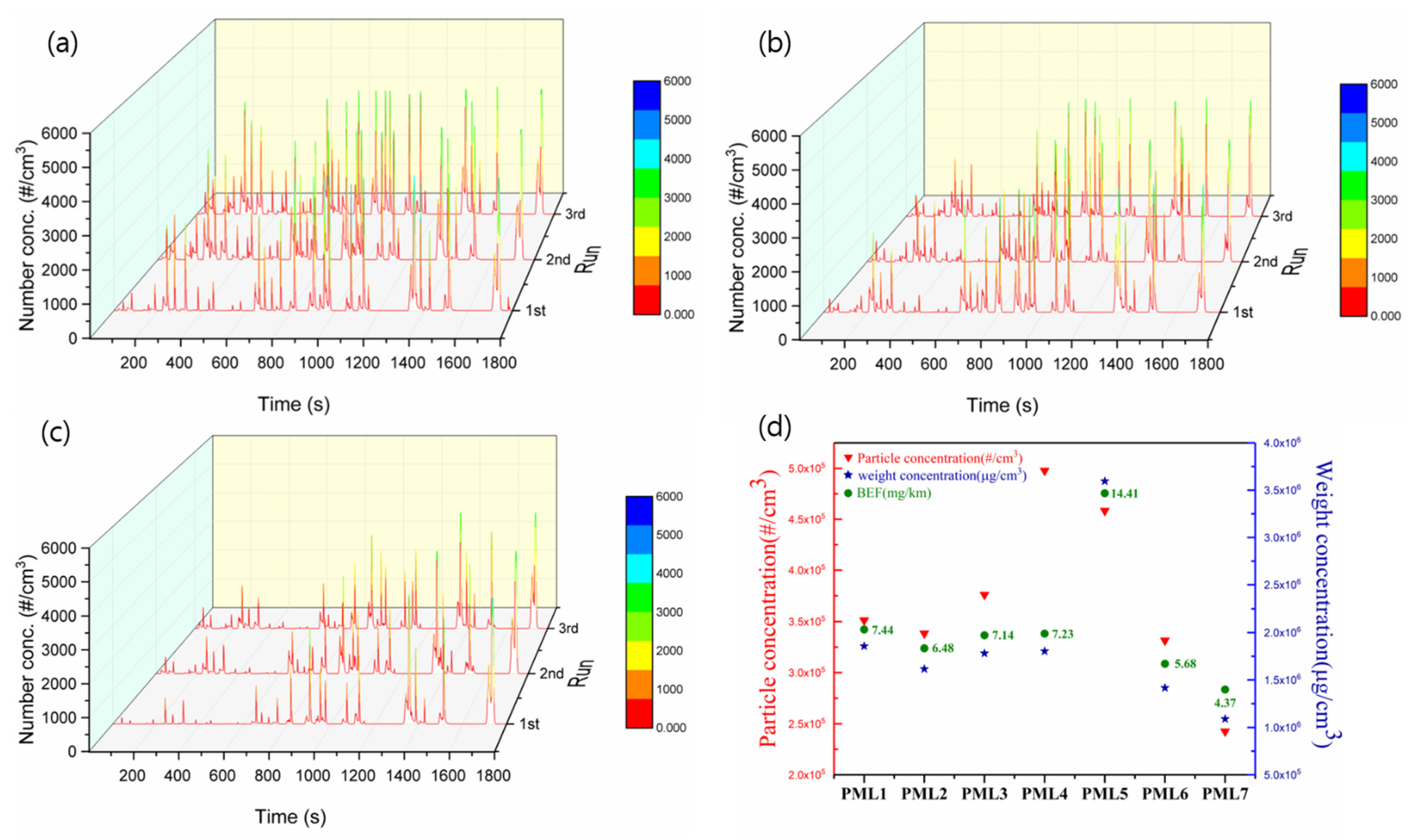

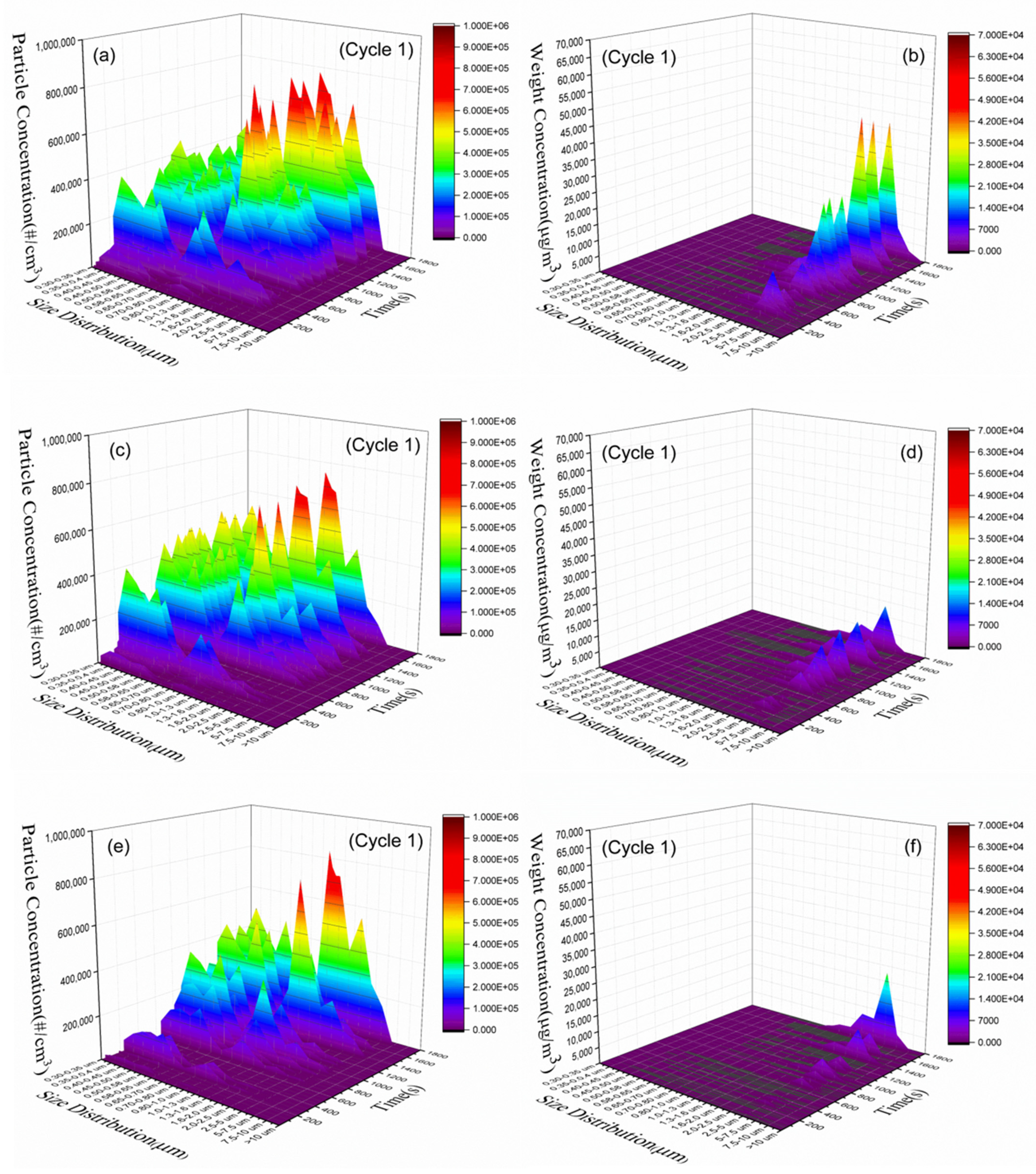
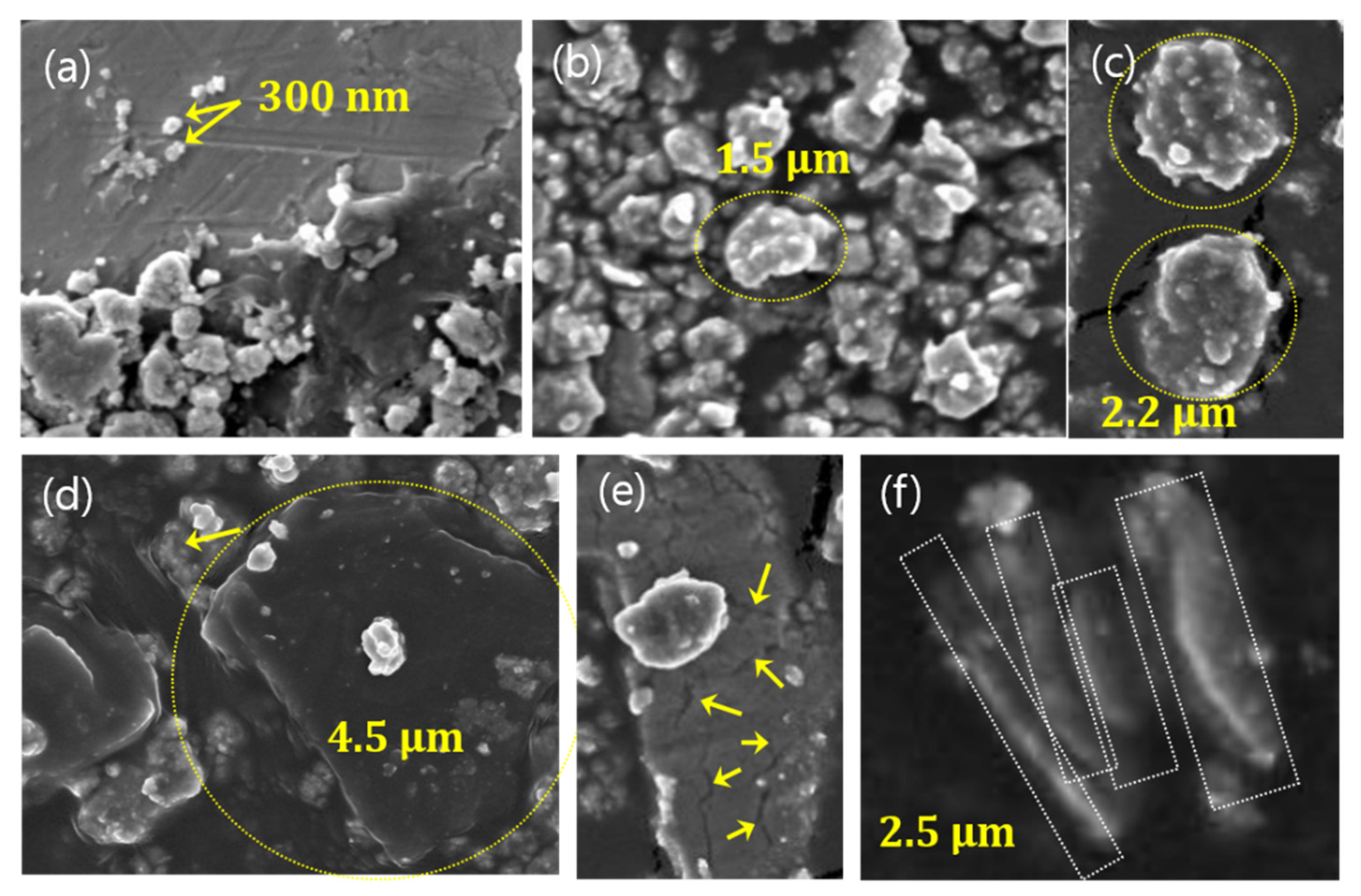



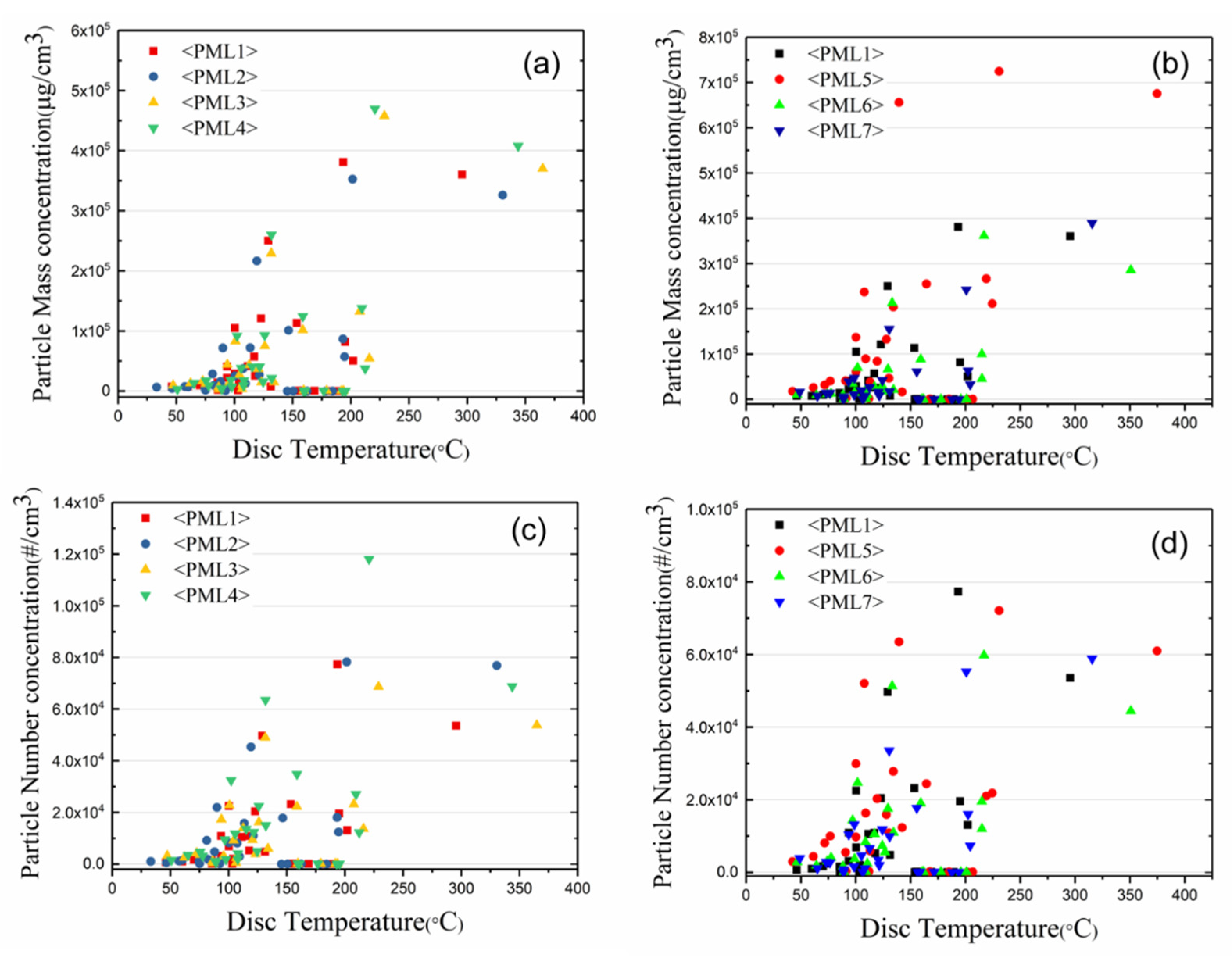
| Materials | Abrasive | Lubricant | Reinforcing Fiber | Modifier |
|---|---|---|---|---|
| PML-1 | SiC/Al2O3/ZrSiO4 | Graphite (700/200/10 μm, 6%) | Steel fiber | Fe3O4, MgO, Iron chromite |
| PML-2 | SiC/Al2O3/ZrSiO4 | Graphite (700 μm, 6%) | ||
| PML-3 | SiC/Al2O3/ZrSiO4 | Graphite (200 μm, 6%) | ||
| PML-4 | SiC/Al2O3/ZrSiO4 | Graphite (10 μm, 6%) | ||
| PML-5 | SiC | Graphite (700/200/10 μm, 6%) | ||
| PML-6 | Al2O3 | Graphite (700/200/10 μm, 6%) | ||
| PML-7 | ZrSiO4 | Graphite (700/200/10 μm, 6%) |
| Friction Materials | CoF | BEF (Brake Emission Factor, mg/km/Vehicle) | BEF | BEF | BEF |
|---|---|---|---|---|---|
| 1st Cycle | 2nd Cycle | 3rd Cycle | Avg. | ||
| PML-1 | 0.434 | 7.04 | 7.47 | 7.82 | 7.44 |
| PML-2 | 0.453 | 5.93 | 6.80 | 6.71 | 6.48 |
| PML-3 | 0.457 | 7.28 | 7.04 | 7.12 | 7.14 |
| PML-4 | 0.451 | 6.72 | 7.42 | 7.56 | 7.23 |
| PML-5 | 0.467 | 10.74 | 16.47 | 16.04 | 14.41 |
| PML-6 | 0.522 | 4.97 | 5.86 | 6.23 | 5.68 |
| PML-7 | 0.382 | 3.47 | 4.68 | 4.96 | 4.37 |
| Friction Materials | PML-1 | PML-2 | PML-3 | PML-4 |
|---|---|---|---|---|
| Color map of height | 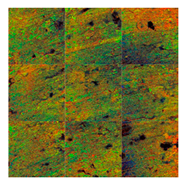 |  | 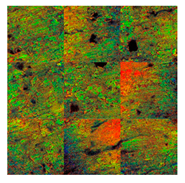 | 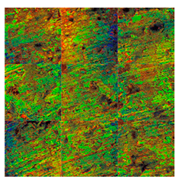 |
| Area (High, %) | 14.9 | 21.7 | 48.5 | 32.2 |
| Area (Middle, %) | 63.9 | 46.9 | 39.8 | 46.3 |
| Area (Low, %) | 17.4 | 29.4 | 12.5 | 21.0 |
| Ra, μm | 3.32 | 2.79 | 2.94 | 2.76 |
| Emission factor (mg/km/v) | 7.44 | 6.48 | 7.14 | 7.23 |
| Friction Materials | PML-5 | PML-6 | PML-7 | |
| Color map of height | 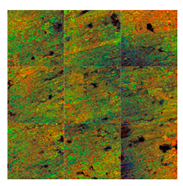 |  |  | |
| Area (High, %) | 24.3 | 21.0 | 23.0 | |
| Area (Middle, %) | 49.5 | 48.4 | 42.1 | |
| Area (Low, %) | 25.9 | 26.3 | 27.7 | |
| Ra, μm | 5.16 | 2.96 | 2.41 | |
| Emission (mg/km/v) | 14.41 | 5.68 | 4.37 | |
Publisher’s Note: MDPI stays neutral with regard to jurisdictional claims in published maps and institutional affiliations. |
© 2021 by the authors. Licensee MDPI, Basel, Switzerland. This article is an open access article distributed under the terms and conditions of the Creative Commons Attribution (CC BY) license (https://creativecommons.org/licenses/by/4.0/).
Share and Cite
Kim, S.-H.; Jeong, M.H.; Kim, J.; Shim, W.; Kwon, S.-U.; Lee, J.-J.; Huh, S.H.; Pee, J.-H.; Kim, J.-Y. Dynamometric Investigation on Airborne Particulate Matter (PM) from Friction Materials for Automobile: Impact of Abrasive and Lubricant on PM Emission Factor. Lubricants 2021, 9, 118. https://doi.org/10.3390/lubricants9120118
Kim S-H, Jeong MH, Kim J, Shim W, Kwon S-U, Lee J-J, Huh SH, Pee J-H, Kim J-Y. Dynamometric Investigation on Airborne Particulate Matter (PM) from Friction Materials for Automobile: Impact of Abrasive and Lubricant on PM Emission Factor. Lubricants. 2021; 9(12):118. https://doi.org/10.3390/lubricants9120118
Chicago/Turabian StyleKim, Sung-Hun, Mu Hyeok Jeong, Jaegyeom Kim, Wooyoung Shim, Sung-Uk Kwon, Jung-Ju Lee, Seung Hun Huh, Jae-Hwan Pee, and Jong-Young Kim. 2021. "Dynamometric Investigation on Airborne Particulate Matter (PM) from Friction Materials for Automobile: Impact of Abrasive and Lubricant on PM Emission Factor" Lubricants 9, no. 12: 118. https://doi.org/10.3390/lubricants9120118
APA StyleKim, S.-H., Jeong, M. H., Kim, J., Shim, W., Kwon, S.-U., Lee, J.-J., Huh, S. H., Pee, J.-H., & Kim, J.-Y. (2021). Dynamometric Investigation on Airborne Particulate Matter (PM) from Friction Materials for Automobile: Impact of Abrasive and Lubricant on PM Emission Factor. Lubricants, 9(12), 118. https://doi.org/10.3390/lubricants9120118






